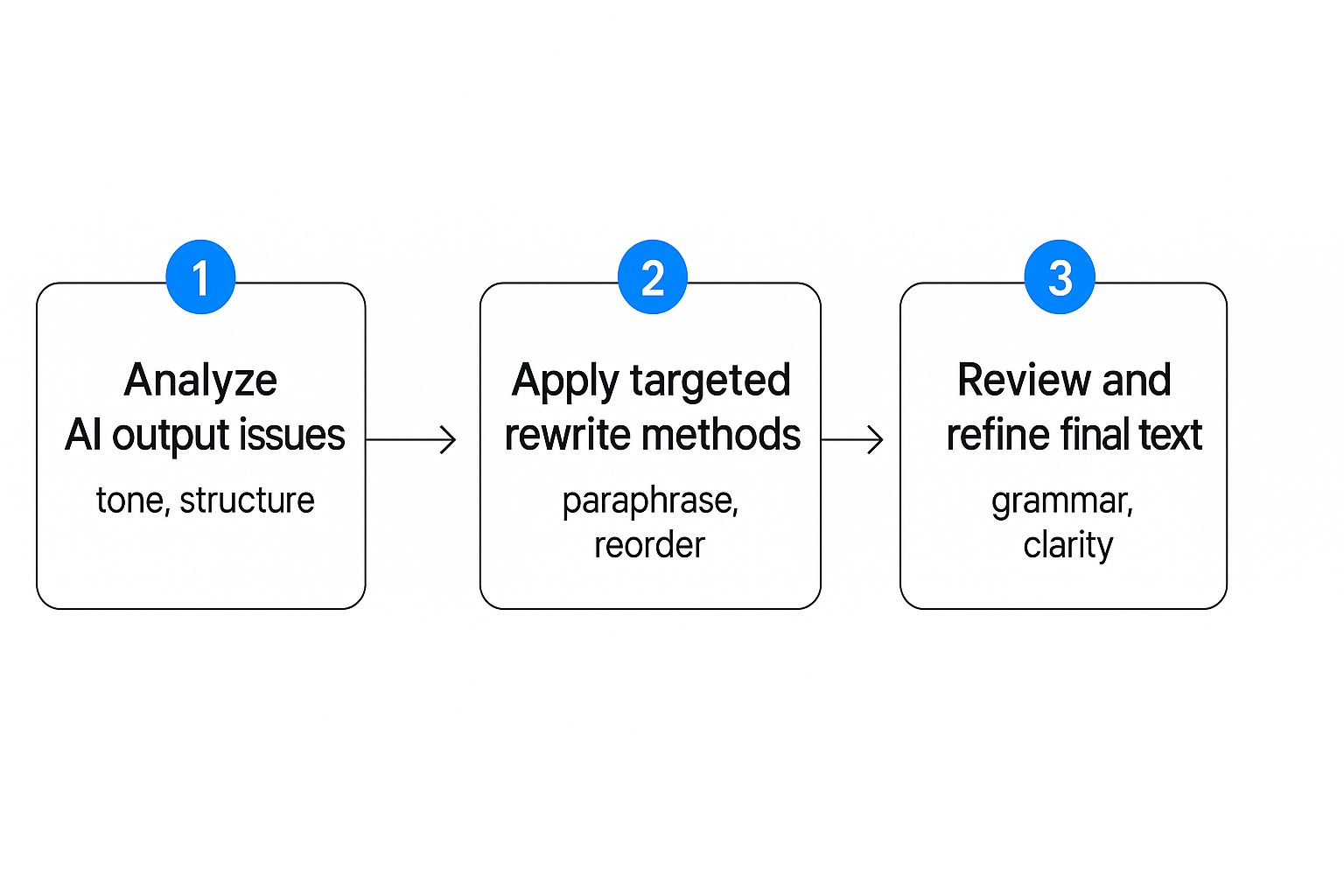How to Rewrite AI-Generated Text for Authentic Content

You can usually tell when something was written by a machine, can't you? The text is often a little too perfect, the sentence structures feel repetitive, or it just lacks a genuine personality. While AI is a fantastic starting point for getting past writer's block and producing a first draft, it simply can't capture the small details that truly connect with a human reader.
This is exactly where the human touch becomes essential. When you sit down to rewrite AI-made text, you’re not just cleaning up grammar—you're breathing life into the words.
Maintaining Your Unique Brand Voice
Your brand's voice is its personality. It's what makes you instantly recognizable and helps you build a real relationship with your audience. An AI model, no matter how clever, doesn't know the inside jokes, the industry-specific slang, or the particular way you talk to your customers.
Without a human editor steering the ship, your content risks sounding completely generic, like it could have been written by absolutely anyone. A hands-on rewrite makes sure that every single blog post, email, or social update sounds distinctly like you.
Building Trust Through Authenticity
Let's be real: your readers are smart. They can easily spot content that feels impersonal and lacks genuine thought. Authentic writing is what builds trust, and trust is the foundation of any strong relationship, whether it's with customers, clients, or subscribers.
A human editor does more than just edit; they act as the reader's champion, making sure the content is not only correct but also relatable and trustworthy. They're the ones who add the stories and personal touches that make your message stick.
To get this right, focus on a few key things during your rewrite:
- Inject Personal Anecdotes: Share a short, relevant story that brings your point to life.
- Ask Rhetorical Questions: Pull the reader in and get them thinking.
- State Clear Opinions: Don't be afraid to take a stance on a topic. It shows you're not a robot.
Adding Value Beyond the Obvious
AI is great at gathering information from the web and summarizing what already exists. What it can't do is come up with brand-new, original thoughts from personal experience. It often gives you surface-level content that just states the obvious without offering any real, tangible worth. To truly rewrite AI-made text, you have to dig deeper.
For instance, an AI might list the "top benefits of email marketing." A human writer, on the other hand, can add a specific example of a campaign that completely flopped and, more importantly, what they learned from that failure.
This kind of firsthand knowledge is priceless and is exactly what will set your content apart from the thousands of other articles on the same topic. By adding that layer of human experience, you turn a generic draft into a valuable resource that people will actually remember and share.
Before we move on, let's look at a simple breakdown of what separates a raw AI draft from a piece of content that's been polished by a human editor. The difference is often in the subtle details that build connection and authority.
Comparing AI Drafts and Human-Edited Content
| Characteristic | Typical AI Draft | Human-Edited Content |
|---|---|---|
| Tone & Voice | Often generic, formal, or overly enthusiastic. | Matches a specific brand voice; can be witty, empathetic, or authoritative. |
| Flow & Rhythm | Can be repetitive with similar sentence lengths and structures. | Varies sentence structure for better readability and a more natural rhythm. |
| Originality | Summarizes existing information without new thoughts. | Includes individual perspectives, personal anecdotes, and original ideas. |
| Emotional Connection | Lacks empathy and struggles to connect with the reader on an emotional level. | Uses storytelling and relatable language to build a genuine connection. |
| Credibility | States facts but lacks the depth of real-world experience. | Builds trust by sharing firsthand experiences, including both successes and failures. |
As you can see, the value isn't just in correcting errors but in adding layers of personality and experience that AI simply can't create on its own. It's this human element that turns good content into great content.
Getting Your AI Draft Ready for a Human Touch
Before you even think about dropping your AI-made text into a tool, there’s a key preparation phase. Think of it like a chef preparing ingredients—getting everything ready makes the final dish so much better. Jumping straight into rewriting without a plan is a recipe for a messy, jumbled final product.
First, you need to understand what you're working with. AI drafts, especially from models like ChatGPT, are often a mixed bag. They can be very helpful for structure and ideas, but they also come with tell-tale signs of where they came from: repetitive phrasing, an overly formal tone, and a clear lack of personality. Your job is to find these weak spots before you start the rewrite.
The Initial Read-Through
Pour yourself a coffee and do a full read-through of the entire AI draft. Don't edit anything just yet. The goal here is to get a feel for the content's flow (or lack thereof).
As you read, keep an eye out for a few key things:
- Repetitive sentence starters: Does every other paragraph begin with "In addition," or "Furthermore,"? AI loves these generic transitions.
- Unnatural vocabulary: AI often uses overly complex or slightly “off” words where a simpler, more natural term would work better.
- Lack of a distinct voice: The text probably sounds generic and neutral. This is your biggest opportunity to inject personality.
- Factual correctness: Never, ever trust an AI's facts without checking. Cross-check any stats, dates, or claims with reliable sources.
A quick "pre-edit" can work wonders. This isn't a deep dive, but a light cleanup. Fix obvious typos, delete any completely irrelevant sentences, and maybe break up some of those massive, intimidating paragraphs that AI is known for creating. This step alone makes the draft far less overwhelming to work with when you move into the actual humanization part.
Adding the Final Polish to Your Writing
This final editing stage is what really separates good content from great content. You've done the heavy lifting to humanize the text, but now it's time to make it a polished, professional piece. These last few checks might seem small, but they make a huge difference.
One of the most effective tricks in the book is to read your text out loud. I know, it feels a bit weird at first, but your ears will catch what your eyes skim over. Clunky sentences, awkward phrasing, and a choppy rhythm become very obvious when you hear them spoken.
Trust me, this is the single best way to test the natural flow of your writing. If you stumble over a sentence, your reader will too.
Fine-Tuning for Clearness and Credibility
Once you've ironed out the rhythm, it's time to zoom in on the finer details. Proofreading for grammar, spelling, and punctuation is a must. Even tiny mistakes can chip away at your credibility and weaken your message.
But improving your AI-made drafts means going beyond just fixing typos. It's about committing to a high standard of clearness and precision. Applying core principles, like those found in the best practices for technical writing, can help you achieve that professional edge.
Your Final Review Checklist
Before you hit publish, give it one last quick scan. This isn't about deep, line-by-line editing anymore. It's a high-level check to make sure everything hangs together and is ready for your audience.
The goal of the final polish is simple: make sure every word serves a purpose. It's your last chance to cut the fluff and sharpen your message.
Run through this quick checklist to be sure:
- Consistent Tone: Does the voice feel the same from the first paragraph to the last?
- Clear Purpose: Does the content actually achieve its goal—to inform, persuade, or entertain?
- Logical Flow: Do the ideas connect smoothly, guiding the reader from one point to the next without any jarring jumps?
- Formatting Check: Are headings, lists, and bold text used effectively to make the content easy to scan and read?
Going through these final steps makes sure your efforts to rewrite ai generated text create a piece that is not only human-sounding but also polished and genuinely impactful. For a deeper dive into this, check out our guide on how to humanize AI text.
Building an Efficient Rewriting Workflow
Let's be honest, manually rewriting every single piece of AI-made content is a one-way ticket to burnout. A much smarter approach is to build a repeatable routine that blends your own editing magic with the right tools. This is how you get from a clunky, robotic first draft to a polished, final piece without losing your mind.
The method doesn't need to be some overly complex system. It usually starts with getting that initial draft from your AI of choice. Then, you bring in a specialized tool to do the heavy lifting—the rephrasing and restructuring. For anyone needing to humanize text and remove AI detection, a tool like Word Spinner is a leading choice. It offers advanced rewriting that produces a natural tone and guarantees 100% plagiarism-free output, giving you a much stronger foundation to work from.
Structuring Your Process
An effective routine brings a little order to the creative chaos. Instead of trying to fix everything at once, you break the job down into manageable stages. It’s a simple shift, but it prevents you from feeling overwhelmed and, frankly, leads to much better results. You move from a big-picture review to fine-tuning the details.
For anyone who needs to rewrite ai generated text on a regular basis, this kind of structured approach is a must. It’s what helps you maintain quality and consistency across all your content without hitting a wall.
This visual breaks down a simple but very powerful three-step flow for improving AI text.
As you can see, rewriting isn't just about swapping out words. It's a thoughtful method of looking at the draft, applying specific techniques to improve it, and then polishing the final output until it's clear, punchy, and has an effect.
Choosing the Right Tools for the Job
Your routine is only as good as the tools in your toolbox. While a simple grammar checker is great for a final once-over, it can't handle the core task of humanizing your text. For that, you need software specifically designed to improve the natural flow and rephrase content in a way that sounds genuinely human.
Many creators find that a specialized rewriter is a huge help. It’s built from the ground up to rework text, stripping away the stiffness that screams "AI-written." This gives you a solid base to work from, so your final edit is about adding value, not just fixing robotic language.
The reliance on AI in content creation is no secret. Recent data shows just how common it has become:
- 71.7% of content marketers use AI for outlining.
- 68% use it for brainstorming ideas.
- 57.4% use it for creating first drafts.
These numbers make it very clear that AI is a fixture in the content process, which means having good rewriting skills is more crucial than ever.
A great routine isn't about replacing the human editor. It's about giving them the right tools to do their best work faster, turning a generic AI draft into something truly compelling.
This combination of a smart method and powerful tools is what separates good content from great content. It allows you to create high-quality, authentic pieces consistently. If you're interested in the more technical side of this, be sure to check out our guide on how to bypass AI detection in your writing.

